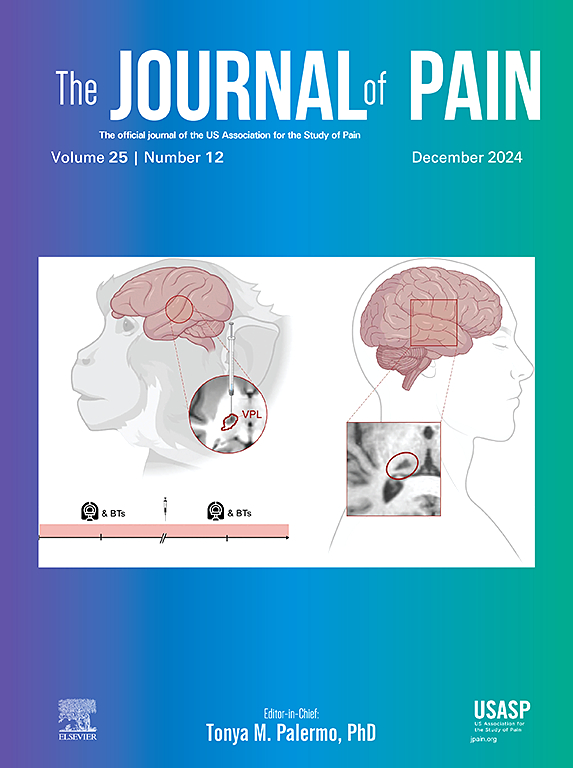诱发复合动作电位控制、闭环脊髓刺激治疗体验的改善--ECHO-MAC 随机临床试验的主要结果。
IF 4
2区 医学
Q1 CLINICAL NEUROLOGY
引用次数: 0
摘要
脊髓刺激(SCS)是一种行之有效的治疗慢性神经病理性疼痛的方法。然而,由于刺激电极与脊髓之间的间距并不固定,因此可能会出现脊髓刺激剂量过高或过低的情况;间距会随着运动和姿势的改变而变化,这可能会导致脊髓刺激剂量的变化,进而给患者带来不理想的治疗体验。诱发复合动作电位(ECAP)是神经激活的一种测量方法,可用作实时调整 SCS 参数的控制信号,以补偿这种可变性。在这项前瞻性、多中心、随机、单盲、交叉试验中,过度刺激强度的降低被用作感知指标,以评估新型 ECAP 控制闭环 (CL) SCS 算法相对于传统开环 (OL) SCS 的效果。主要结果采用李克特量表来评估CL与OL SCS在日常生活活动中的感觉。在意向治疗分析组的42名受试者中,97.6%的受试者在使用CL与OL SCS时感觉有所减弱。由于置信度下限(87.4%)超过了 50%(p < 0.001)的绩效目标,因此达到了主要目标。共有 88.1%(37/42)的受试者倾向于 CL,11.9%(5/42)的受试者倾向于 OL SCS。CL SCS(标度:8.72 µV)与 OL SCS(标度:19.95 µV)相比,CL SCS 的 ECAP 振幅变异性更小,这证明了 CL SCS 期间 SCS 剂量的一致性。总之,这些结果表明,ECAP 控制的 CL 算法减少或消除了不必要的感觉,从而提供了更理想、更一致的 SCS 体验。观点:慢性疼痛患者需要持久可靠的止痛方法。SCS 是一种重要的治疗方法,新技术的进步可以改善长期治疗的效果。闭环 SCS 可为患者提供更佳、更稳定的治疗体验,从而提高治疗利用率并获得可靠的治疗效果。本文章由计算机程序翻译,如有差异,请以英文原文为准。
Improvements in Therapy Experience With Evoked Compound Action Potential Controlled, Closed-Loop Spinal Cord Stimulation—Primary Outcome of the ECHO-MAC Randomized Clinical Trial
Spinal cord stimulation (SCS) is a well-established treatment for chronic neuropathic pain. However, over- or underdelivery of the SCS may occur because the spacing between the stimulating electrodes and the spinal cord is not fixed; spacing changes with motion and postural shifts may result in variable delivery of the SCS dose and, in turn, a suboptimal therapy experience for the patient. The evoked compound action potential (ECAP)—a measure of neural activation—may be used as a control signal to adapt SCS parameters in real time to compensate for this variability. In this prospective, multicenter, randomized, single-blind, crossover trial, reduction in overstimulation intensity was used as a perceptual measure to evaluate a novel ECAP-controlled, closed-loop (CL) SCS algorithm relative to traditional open-loop (OL) SCS. The primary outcome used a Likert scale to assess sensation during activities of daily living with CL versus OL SCS. Of the 42 subjects in the intent-to-treat analysis set, 97.6% had a reduction in sensation with CL versus OL SCS. The primary objective was met as the lower confidence limit (87.4%) exceeded the performance goal of 50% (P < .001). A total of 88.1% (37/42) of subjects preferred CL and 11.9% (5/42) preferred OL SCS. SCS dose consistency during CL SCS was demonstrated by the reduced variability in ECAP amplitude with CL SCS (standard deviation: 8.72 µV) relative to OL SCS (standard deviation: 19.95 µV). Together, these results demonstrate that the ECAP-controlled, CL algorithm reduces or eliminates unwanted sensation, and thereby provides a more preferred and consistent SCS experience.
Perspective
Patients with chronic pain need durable and dependable options for pain relief. SCS is an important therapy option, and new technology advancements could improve long-term therapy use. CL SCS offers a preferred and more consistent therapy experience for patients that could lead to increased therapy utilization and reliable therapy outcomes.
求助全文
通过发布文献求助,成功后即可免费获取论文全文。
去求助
来源期刊

Journal of Pain
医学-临床神经学
CiteScore
6.30
自引率
7.50%
发文量
441
审稿时长
42 days
期刊介绍:
The Journal of Pain publishes original articles related to all aspects of pain, including clinical and basic research, patient care, education, and health policy. Articles selected for publication in the Journal are most commonly reports of original clinical research or reports of original basic research. In addition, invited critical reviews, including meta analyses of drugs for pain management, invited commentaries on reviews, and exceptional case studies are published in the Journal. The mission of the Journal is to improve the care of patients in pain by providing a forum for clinical researchers, basic scientists, clinicians, and other health professionals to publish original research.
 求助内容:
求助内容: 应助结果提醒方式:
应助结果提醒方式:


